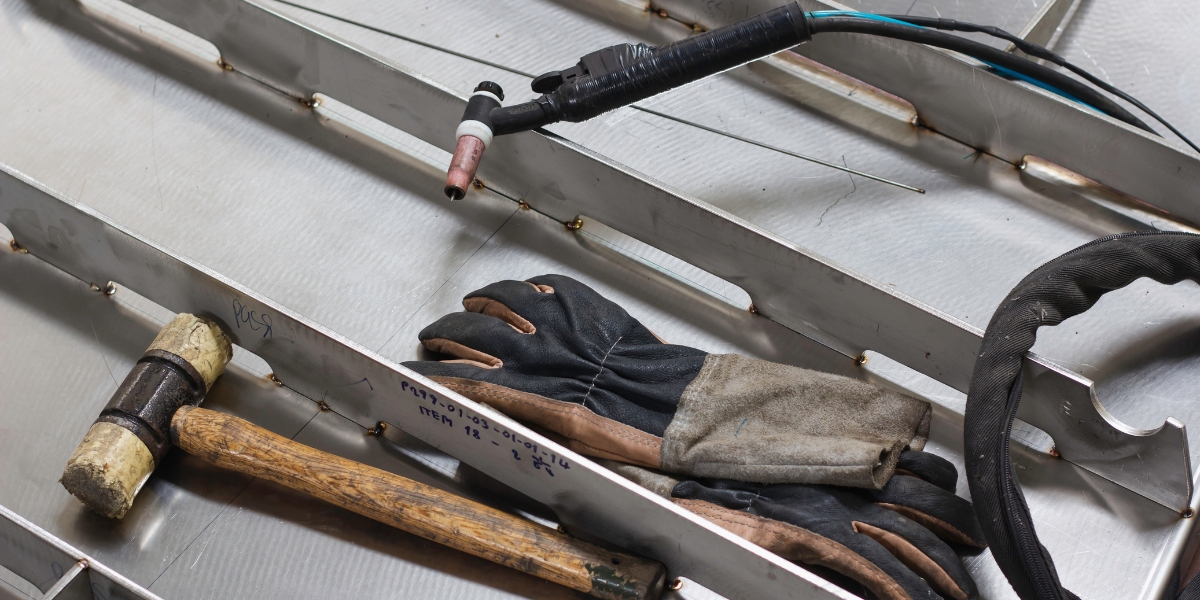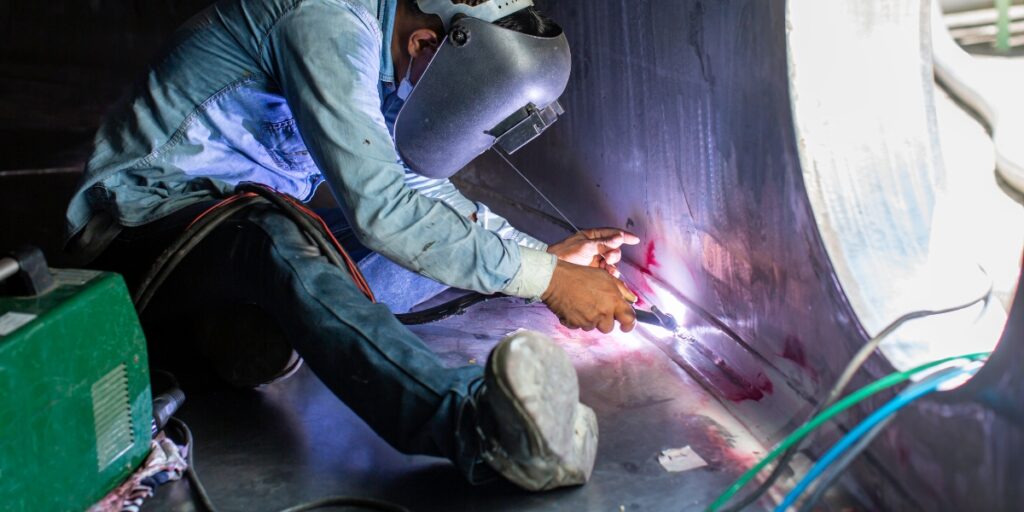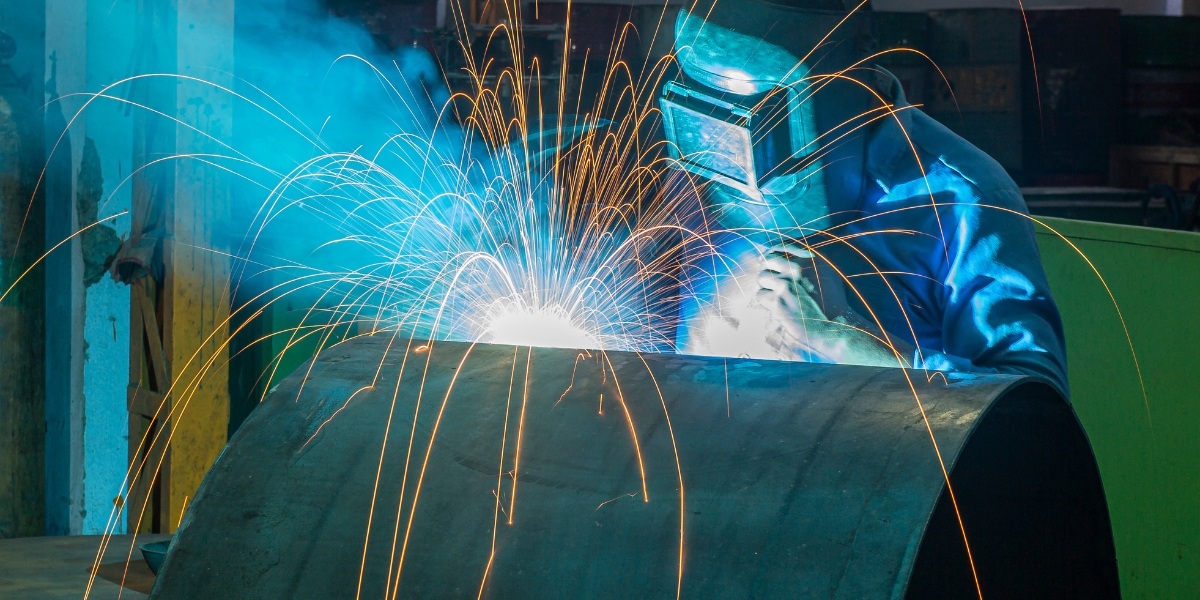Are you interested in learning about welding and metal fabrication?
In this article, we will explore the different types of welding techniques, the essential tools for metal fabrication, and the safety measures you need to take.
We will also discuss the common challenges you may encounter in welding and metal fabrication, as well as the advancements in technology that are revolutionizing this field.
Get ready to dive into the technical and precise world of welding and metal fabrication.
Key Takeaways
– There are multiple welding techniques available, including arc welding, gas welding, resistance welding, laser welding, and 3D metal printing.
– Essential tools for metal fabrication include plasma cutters, MIG welders, bench vises, laser cutting machines, and sheet metal benders.
– Safety measures in welding and metal fabrication include wearing appropriate personal protective equipment (PPE) and using ventilation systems to remove smoke, fumes, and gases.
– Common challenges in welding and metal fabrication include misalignment of materials and troubleshooting welding issues by verifying alignment, checking machine settings, inspecting consumables, and considering welding certifications.
Different Types of Welding Techniques
You should learn about the various types of welding techniques available in order to choose the most suitable one for your project. When it comes to welding process comparison, there are several options to consider.
One common technique is arc welding, which uses an electric arc to create a weld. This method offers high welding speed and can be used for a wide range of materials.
Another technique is gas welding, which uses a flame produced by a mixture of fuel gas and oxygen. Gas welding provides good control over the heat and is often used for thin materials.
Additionally, there’s resistance welding, where heat is generated by passing an electric current through the workpieces. This technique is ideal for joining metals with high electrical resistance.

Essential Tools for Metal Fabrication
The essential tools for metal fabrication include a plasma cutter, a MIG welder, and a bench vise.
These tools are crucial for various processes involved in metal fabrication. The plasma cutter is used to cut metal sheets with precision and speed. It utilizes a high-velocity jet of ionized gas, which melts and removes the metal.
A MIG welder, on the other hand, is used for joining metal pieces together. It uses a consumable wire electrode and an inert shielding gas to create strong and durable welds.
Lastly, a bench vise is essential for securing the metal workpiece during fabrication. It provides stability and allows for accurate measurements and cuts.
Other important tools in metal fabrication include laser cutting machines for intricate cuts and sheet metal benders for shaping metal sheets into desired forms.
Safety Measures in Welding and Metal Fabrication
Always wear appropriate protective gear when engaging in welding and metal fabrication to ensure your safety. Personal protective equipment (PPE) is essential to protect yourself from potential hazards such as sparks, metal fragments, and harmful fumes. It is crucial to have a thorough understanding of the necessary PPE and how to use it correctly. In addition to PPE, ventilation systems play a significant role in maintaining a safe working environment. They help remove smoke, fumes, and gases generated during the welding process. Here is a visual representation of the recommended PPE and ventilation systems:
| Personal Protective Equipment (PPE) | Ventilation Systems |
| Welding helmet | Local exhaust |
| Safety glasses | General ventilation |
| Welding gloves | Mechanical |
| Welding apron | |
| Steel-toed boots |
Common Challenges in Welding and Metal Fabrication
One of the common challenges in welding and metal fabrication is that sometimes, the materials may not align properly, causing difficulties in achieving precise welds. This misalignment can occur due to various factors, such as inaccurate measurements, poor joint preparation, or improper clamping techniques.
In order to overcome this challenge and achieve accurate welds, it’s important to carefully troubleshoot the welding issues. Here are four key steps to troubleshoot welding issues:
1. Verify material alignment: Double-check the alignment of the materials before starting the welding process. Ensure that the edges are properly positioned and the joint surfaces are clean and free from any contaminants.
2. Check welding machine settings: Review the welding machine settings to ensure they’re appropriate for the specific materials being welded. Adjust the voltage, amperage, and wire feed speed as needed.
3. Inspect welding consumables: Examine the welding consumables, such as electrodes or filler wires, for any defects or inconsistencies. Replace them if necessary to ensure optimal performance.
4. Consider welding certifications: If the welding issues persist, it may be beneficial to consult a certified welder or obtain welding certifications yourself. These certifications provide valuable knowledge and skills to troubleshoot and overcome welding challenges effectively.
Advancements in Welding and Metal Fabrication Technologies
You can explore the latest advancements in welding and metal fabrication technologies, such as robotic welding systems and laser cutting machines. These technologies have revolutionized the industry, allowing for greater precision, efficiency, and productivity. One of the most significant advancements is laser welding, which utilizes a high-powered laser beam to join metal components together. This technique offers several advantages over traditional welding methods, including faster welding speeds, reduced heat distortion, and improved weld quality.
Another exciting development in metal fabrication is 3D metal printing. This innovative technology enables the creation of complex metal parts by depositing successive layers of metal powder using a laser or electron beam. 3D metal printing offers unprecedented design freedom, allowing for the production of intricate and customized components with minimal material waste. Moreover, it has the potential to streamline manufacturing processes and reduce lead times. Additionally, 3D metal printing has the capability to significantly reduce the need for traditional machining and tooling, saving both time and resources. This technology is revolutionizing the way metal components are produced, offering a more efficient and cost-effective alternative to traditional metal fabrication techniques. As 3D metal printing continues to advance, it has the potential to become an integral part of the metal fabrication industry, transforming the way metal parts are manufactured.
To further illustrate the advancements in welding and metal fabrication technologies, let’s take a look at the following table:
| Technology | Advantages | Applications |
| Robotic Welding Systems | Increased productivity and precision | Automotive industry, heavy machinery |
| Laser Cutting Machines | High cutting speeds and accuracy | Aerospace, architecture |
| 3D Metal Printing | Complex part production, design flexibility | Medical, aerospace |
As the field of welding and metal fabrication continues to evolve, these advancements play a crucial role in enhancing efficiency and unlocking new possibilities in various industries.
Frequently Asked Questions
What Are the Career Prospects and Job Opportunities in the Field of Welding and Metal Fabrication?
You have asked about career prospects and job opportunities. There are various options available depending on your interests and skills. Let’s explore the field of welding and metal fabrication for potential paths to pursue.
How Long Does It Typically Take to Become a Certified Welder or Metal Fabricator?
To become a certified welder or metal fabricator, the duration of training can vary. However, on average, it typically takes several months to a year to complete the necessary coursework and gain the required experience for certification.
Are There Any Specific Certifications or Licenses Required to Work in the Welding and Metal Fabrication Industry?
To work in welding and metal fabrication, you need to meet specific certification and licensing requirements. These requirements ensure that you have the necessary skills and knowledge to safely and effectively perform the tasks involved in this industry.
What Are Some Common Misconceptions or Myths About Welding and Metal Fabrication?
Common misconceptions about welding and metal fabrication include exaggerated safety risks and health hazards associated with the profession. Additionally, there is a misconception that there are limited career opportunities in this field.
Can Welding and Metal Fabrication Be a DIY Project, or Is It Best Left to Professionals?
Welding and metal fabrication can be a challenging DIY project, but it’s best left to professionals. Their expertise ensures safety, precision, and adherence to industry standards. Don’t risk compromising structural integrity or personal safety.
Conclusion
In conclusion, welding and metal fabrication are complex processes that require knowledge of various techniques and the use of essential tools. It’s crucial to prioritize safety measures to prevent accidents and injuries.
Challenges in welding and metal fabrication include achieving precise welds and ensuring structural integrity. However, advancements in technology continue to improve these processes, making them more efficient and effective.
Overall, the field of welding and metal fabrication offers endless possibilities for creating durable and reliable metal structures.


